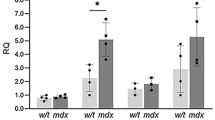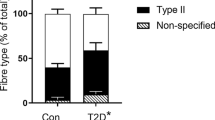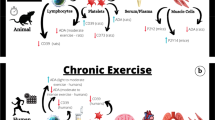Abstract
Purinergic receptors are present in most tissues and thought to be involved in various signalling pathways, including neural signalling, cell metabolism and local regulation of the microcirculation in skeletal muscles. The present study aims to determine the distribution and intracellular content of purinergic receptors in skeletal muscle fibres in patients with type 2 diabetes and age-matched controls. Muscle biopsies from vastus lateralis were obtained from six type 2 diabetic patients and seven age-matched controls. Purinergic receptors were analysed using light and confocal microscopy in immunolabelled transverse sections of muscle biopsies. The receptors P2Y4, P2Y11 and likely P2X1 were present intracellularly or in the plasma membrane of muscle fibres and were thus selected for further detailed morphological analysis. P2X1 receptors were expressed in intracellular vesicles and sarcolemma. P2Y4 receptors were present in sarcolemma. P2Y11 receptors were abundantly and diffusely expressed intracellularly and were more explicitly expressed in type I than in type II fibres, whereas P2X1 and P2Y4 showed no fibre-type specificity. Both diabetic patients and healthy controls showed similar distribution of receptors. The current study demonstrates that purinergic receptors are located intracellularly in human skeletal muscle fibres. The similar cellular localization of receptors in healthy and diabetic subjects suggests that diabetes is not associated with an altered distribution of purinergic receptors in skeletal muscle fibres. We speculate that the intracellular localization of purinergic receptors may reflect a role in regulation of muscle metabolism; further studies are nevertheless needed to determine the function of the purinergic system in skeletal muscle cells.




Similar content being viewed by others
References
Ralevic V, Burnstock G (1998) Receptors for purines and pyrimidines. Pharmacol Rev 50:413–492
Erlinge D, Burnstock G (2008) P2 receptors in cardiovascular regulation and disease. Purinergic Signal 4:1–20
Burnstock G (2004) Introduction: P2 receptors. Curr Top Med Chem 4:793–803
Abbracchio M, Burnstock G, Boeynaems J, Barnard E, Boyer J, Kennedy C, Knight G, Fumagalli M, Gachet C, Jacobson K, Weisman G (2006) International Union of Pharmacology LVIII: update on the P2Y G protein-coupled nucleotide receptors: from molecular mechanisms and pathophysiology to therapy. Pharmacol Rev 58:281–341
Burnstock G (2007) Purine and pyrimidine receptors. Cell Moll Life Sci 64:1471–1483
Wang L, Karlsson L, Moses S, Hultgårdh-Nilsson A, Andersson M, Borna C, Gudbjartsson T, Jern S, Erlinge D (2002) P2 receptor expression profiles in human vascular smooth muscle and endothelial cells. J Cardiovasc Pharmacol 40:841–853
Thaning P, Bune LT, Hellsten Y, Pilegaard H, Saltin B, Rosenmeier JB (2010) Attenuated purinergic receptor function in patients with type 2 diabetes. Diabetes 59:182–189
Mortensen SP, Gonzalez-Alonso J, Bune LT, Saltin B, Pilegaard H, Hellsten Y (2009) ATP-induced vasodilation and purinergic receptors in the human leg: roles of nitric oxide, prostaglandins, and adenosine. Am J Physiol Regul Integr Comp Physiol 296:R1140–R1148
Mortensen SP, Gonzalez-Alonso J, Nielsen J-J, Saltin B, Hellsten Y (2009) Muscle interstitial ATP and norepinephrine concentrations in the human leg during exercise and ATP infusion. J Appl Physiol 107:1757–1762
Kim MS, Lee J, Ha J, Kim SS, Kong Y, Cho YH, Baik HH, Kang I (2002) ATP stimulates glucose transport through activation of P2 purinergic receptors in C2C12 skeletal muscle cells. Arch Bioch Biophys 401:205–214
American, Diabetes, Association (2004) Diagnosis and classification of diabetes mellitus. Diabetes Care 27:s5–s10
Bergström J (1975) Percutaneous needle biopsy of skeletal muscle in physiological and clinical research. Scand J Clin Lab Invest 35:609–616
Vial C, Evans RJ (2000) P2X receptor expression in mouse urinary bladder and the requirement of P2X1 receptors for functional P2X receptor responses in the mouse urinary bladder smooth muscle. Br J Pharmacol 131:1489–1495
Lewis CJ, Gitterman DP, Schlüter H, Evans RJ (2000) Effects of diadenosine polyphosphates (ApnAs) and adenosine polyphospho guanosines (ApnGs) on rat mesenteric artery P2X receptor ion channels. Br J Pharmacol 129:124–130
Lewis CJ, Evans RJ (2000) Lack of run-down of smooth muscle P2X receptor currents recorded with the amphotericin permeabilized patch technique, physiological and pharmacological characterization of the properties of mesenteric artery P2X receptor ion channels. Br J Pharmacol 131:1659–1666
Kim M, Spelta V, Sim J, North RA, Surprenant A (2001) Differential assembly of rat purinergic P2X7 receptor in immune cells of the brain and periphery. J Biol Chem 276:23262–23267
Gitterman DP, Evans RJ (2000) Properties of P2X and P2Y receptors are dependent on artery diameter in the rat mesenteric bed. Br J Pharmacol 131:1561–1568
Gifford SM, Yi F-X, Bird IM (2006) Pregnancy-enhanced Ca2+ responses to ATP in uterine artery endothelial cells is due to greater capacitative Ca2+ entry rather than altered receptor coupling. J Endocrinol 190:373–384
Ennion S, Hagan S, Evans RJ (2000) The role of positively charged amino acids in ATP recognition by human p2x1 receptors. J Biol Chem 275:29361–29367
Malin S, Molliver D (2010) Gi- and Gq-coupled ADP (P2Y) receptors act in opposition to modulate nociceptive signaling and inflammatory pain behavior. Mol Pain 6:21
Ecke D, Hanck T, Tulapurkar ME, Schäfer R, Kassack M, Stricker R, Reiser G (2008) Hetero-oligomerization of the P2Y11 receptor with the P2Y1 receptor controls the internalization and ligand selectivity of the P2Y11 receptor. Biochem J 409:107–116
Lin JHC, Takano T, Arcuino G, Wang X, Hu F, Darzynkiewicz Z, Nunes M, Goldman SA, Nedergaard M (2007) Purinergic signaling regulates neural progenitor cell expansion and neurogenesis. Dev Biol 302:356–366
Knight MM, McGlashan SR, Garcia M, Jensen CG, Poole CA (2009) Articular chondrocytes express connexin 43 hemichannels and P2 receptors—a putative mechanoreceptor complex involving the primary cilium? J Anat 214:275–283
Fischer W, Nörenberg W, Franke H, Schaefer M, Illes P (2009) Increase of intracellular Ca2+ by P2Y but not P2X receptors in cultured cortical multipolar neurons of the rat. J Comp Neurol 516:343–359
Yu J, Sheung N, Soliman EM, Spirli C, Dranoff JA (2009) Transcriptional regulation of IL-6 in bile duct epithelia by extracellular ATP. Am J Physiol Gastrointest Liver Physiol 296:G563–G571
Vaughan KR, Stokes L, Prince LR, Marriott HM, Meis S, Kassack MU, Bingle CD, Sabroe I, Surprenant A, Whyte MKB (2007) Inhibition of neutrophil apoptosis by ATP is mediated by the P2Y11 receptor. J Immunol 179:8544–8553
Lugo-Garcia L, Nadal B, Gomis R, Petit P, Gross R, Lajoix AD (2008) Human pancreatic islets express the purinergic P2Y11 and P2Y12 receptors. Horm Metab Res 40:827–830
Klein C, Grahnert A, Abdelrahman A, Müller CE, Hauschildt S (2009) Extracellular NAD+ induces a rise in [Ca2+]i in activated human monocytes via engagement of P2Y1 and P2Y11 receptors. Cell Calcium 46:263–272
Gulbransen BD, Sharkey KA (2009) Purinergic neuron-to-glia signaling in the enteric nervous system. Gastroenterology 136:1349–1358
Brandenburg L-O, Jansen S, Wruck CJ, Lucius R, Pufe T (2010) Antimicrobial peptide rCRAMP induced glial cell activation through P2Y receptor signalling pathways. Mol Immunol 47:1905–1913
Shanker G, Kontos J, Eckman D, Wesley-Farrington D, Sane D (2006) Nicotine upregulates the expression of P2Y12 on vascular cells and megakaryoblasts. J Thromb Thrombolysis 22:213–220
Ploug T, van Deurs B, Ai H, Cushman SW, Ralston E (1998) Analysis of GLUT4 distribution in whole skeletal muscle fibers: identification of distinct storage compartments that are recruited by insulin and muscle contractions. J Cell Biol 142:1429–1446
von Zglinicki T, Brunk UT (1993) Intracellular interactions under oxidative stress and aging: a hypothesis. Z Gerontol 26:215–220
Sohal RS, Wolfe LS (1986) Chapter 11 lipofuscin: characteristics and significance. Prog Brain Res 70:171–183
Sohal RS, Brunk UT (1989) Lipofuscin as an indicator of oxidative stress and aging. Adv Exp Med Biol 266:17–26
Kiefer CR, McKenney JB, Trainor JF, Lambrecht RW, Bonkovsky HL, Lifshitz LM, Valeri CR, Snyder LM (1998) Porphyrin loading of lipofuscin granules in inflamed striated muscle. Am J Pathol 153:703–708
Ryder J, Chibalin A, Zierath J (2001) Intracellular mechanisms underlying increases in glucose uptake in response to insulin or exercise in skeletal muscle. Acta Physiol Scand 171:249–257
Hellsten Y, Maclean D, Radegran G, Saltin B, Bangsbo J (1998) Adenosine concentrations in the interstitium of resting and contracting human skeletal muscle. Circulation 98:6–8
Durham WJ, Yeckel CW, Miller SL, Gore DC, Wolfe RR (2003) Exogenous nitric oxide increases basal leg glucose uptake in humans. Metabolism 52:662–665
Bradley SJ, Kingwell BA, McConell GK (1999) Nitric oxide synthase inhibition reduces leg glucose uptake but not blood flow during dynamic exercise in humans. Diabetes 48:1815–1821
Kingwell BA, Formosa M, Muhlmann M, Bradley SJ, McConell GK (2002) Nitric oxide synthase inhibition reduces glucose uptake during exercise in individuals with Type 2 diabetes more than in control subjects. Diabetes 51:2572–2580
Ohnishi T, Matsumura S, Ito S (2009) Translocation of neuronal nitric oxide synthase to the plasma membrane by ATP is mediated by P2X and P2Y receptors. Mol Pain 5:40
Merry TL, McConell GK (2009) Skeletal muscle glucose uptake during exercise: a focus on reactive oxygen species and nitric oxide signaling. IUBMB Life 61:479–484
Frandsen U, Lopez-Figueroa M, Hellsten Y (1996) Localization of nitric oxide synthase in human skeletal muscle. Biochem Biophys Res Commun 227:88–93
Balogh J, Wihlborg A-K, Isackson H, Joshi BV, Jacobson KA, Arner A, Erlinge D (2005) Phospholipase C and cAMP-dependent positive inotropic effects of ATP in mouse cardiomyocytes via P2Y11-like receptors. J Mol Cell Cardiol 39:223–230
Hou M, Malmsjö M, Möller S, Pantev E, Bergdahl A, Zhao X-H, Sun X-Y, Hedner T, Edvinsson L, Erlinge D (1999) Increase in cardiac P2X1- and P2Y2-receptor mRNA levels in congestive heart failure. Life Sci 65:1195–1206
Dutton JL, Poronnik P, Li GH, Holding CA, Worthington RA, Vandenberg RJ, Cook DI, Barden JA, Bennett MR (2000) P2X1 receptor membrane redistribution and down-regulation visualized by using receptor-coupled green fluorescent protein chimeras. Neuropharmacology 39:2054–2066
Malmsjö M, Edvinsson L, Erlinge D (1998) P2U-receptor mediated endothelium-dependent but nitric oxide-independent vascular relaxation. Br J Pharmacol 123:719–729
Dorsam RT, Kunapuli SP (2004) Central role of the P2Y12 receptor in platelet activation. J Clin Invest 113:340–345
Acknowledgements
We thank Nethe Kristensen for technical support and Professor Ylva Hellsten and Professor Bengt Saltin (The Copenhagen Muscle Research Centre) for guidance and assistance. Novo Nordisk A/S financially supported the study.
Author information
Authors and Affiliations
Corresponding author
Rights and permissions
About this article
Cite this article
Bornø, A., Ploug, T., Bune, L.T. et al. Purinergic receptors expressed in human skeletal muscle fibres. Purinergic Signalling 8, 255–264 (2012). https://doi.org/10.1007/s11302-011-9279-y
Received:
Accepted:
Published:
Issue Date:
DOI: https://doi.org/10.1007/s11302-011-9279-y




